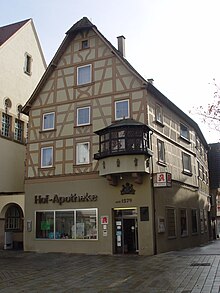Farm pharmacy (Sigmaringen)
| Privileged farm pharmacy
|
|
|---|---|
| legal form | |
| founding | 1579 |
| Seat | Sigmaringen |
| management | Monika Mettenleiter |
| Branch | pharmacy |
| Website | www.Hof-Apotheke-Sigmaringen.de |
The Privileged Hof-Apotheke in Sigmaringen is a historic pharmacy at Apothekergasse 1.
history
A Sigmaringer pharmacy was mentioned for the first time in a sales note from a pharmacist Volz to a pharmacist Meixner from Munich in 1579. In 1601 Bartholome May was employed as a pharmacist at court. There he received his clothes and food and a salary of 30 guilders a year. In 1680 the bricklayer Markus Loos immigrated from Immenstadt im Allgäu to Sigmaringen and from 1705 to 1707 he built what is now the farm pharmacy as his home with agriculture. In 1732 Johann Jacob Loos took over the house from his father and settled in it in the same year as a surgeon and pharmacist. In 1755 Johan Jacob Loos was unanimously elected city school by the local councils. In 1762 his nephew Johann Peter Loos, who was also a surgeon and pharmacist, became the owner of the pharmacy and set up a training institute for surgery in the house. In 1804 he handed the pharmacy over to his son-in-law Benedikt Mühleisen. Like his uncle, Peter Loos was also elected city scholar. In 1816 he received the title of " court pharmacist " from Prince Anton Alois .
In 1831 the pharmacist Georg Baumeister, who studied in Großtissen near Saulgau and in Freiburg , bought the pharmacy and ran it until 1868. His successor was Hermann habenicht from Hanover . In 1879 Bernhard Himmelsbach from Oberweier became the new pharmacist. In 1892 the pharmacist Gustav Kayser bought the house and rebuilt it . The bay window was built in his time . He was succeeded in 1912 by Franz Laws from Bunzlau in Silesia, who in 1919 sold the pharmacy to Kurt Krafft.
In 1938 the Dresden pharmacist Karl Richter († 1946) acquired the house. During the Second World War , the company struggled with the lack of supplies, but was still able to hold its own. Karl Richter tried to preserve the old character of the pharmacy. After his death, the pharmacy remained in the hands of the Richter family. After the takeover by Karl-Jörg Richter in 1957, the second upper floor and the attic were rebuilt, and in 1960–61 it was rebuilt and renovated again. The pharmacy remained the only one in Sigmaringen until modern times.
After Richter's death, Monika Mettenleiter took over the pharmacy shortly before the operating license expired and operated it until 2015. Then she announced the closure, as there were too many pharmacies in Sigmaringen and the economic situation, among other things, due to many vacancies in the city center had deteriorated. In November 2015 the building changed hands.
Farm pharmacy as an institution
Several authors wrote or mentioned the pharmacy in their works. The author Anton Gabele mentions the pharmacy in his autobiographical work Haus zur Sonne (1953) and describes “The coat of arms of the Princes of Hohenzollern hangs next to the writing under the bay window, as it were as a seal on the certificate.” As Sigmaringen from 1944 to 1945 headquarters of the Vichy regime , the writer Louis-Ferdinand Celine came to the city. In his work D'un château à l'autre (1957) he describes the plight in which the city and the pharmacy found themselves during the war. Even Peter Bamm , employees of the newspaper German future , mentioned his conversation with a socially critical pharmacists from Sigmaringen, presumably Dr. Schröppel, who worked in the pharmacy from 1948 to 1952.
building
The house in which the pharmacy was located dates from 1705. It is a listed building. On the first floor there was a treatment and death room from the time when the respective pharmacist also worked as a doctor. In the former death room, now converted into a library, there is a ceiling painting Meinrad von Ows , which shows Saint Barbara . After the pharmacy has been closed, the house is for sale, the city of Sigmaringen is currently discussing taking over the building for administrative purposes. One of the most famous residents of the house was probably the art historian Hans Kayser , the son of Gustav Kayser.
literature
- Walther Frick: The privileged court pharmacy in Sigmaringen: 250 years. M. Liehners Hofbuchdruckerei, Sigmaringen 1982.
Individual evidence
- ↑ a b Christoph Wartenberg, Michael Hescheler: After 435 years the pharmacy closes on the market . In: Schwäbische Zeitung, January 22, 2015
- ↑ Court pharmacy has been sold . In: Schwäbische Zeitung, November 20, 2015
Web links
- Official website
- Dep. 1 T 6-7 No. 183. Court pharmacy (1579 - 1946). In: Finding aid for the Dep. 1 T 6-7 - structure view. Stock Dep. 1 T 6-7: Sigmaringen City Archives: Franz Keller estate. Doctors, midwives, pharmacies, drugs, healers. Sigmaringen State Archives , November 7, 2009, accessed on November 7, 2009 (completed October 2, 1946. Keller).
Coordinates: 48 ° 5 '12.1 " N , 9 ° 13' 0.4" E



